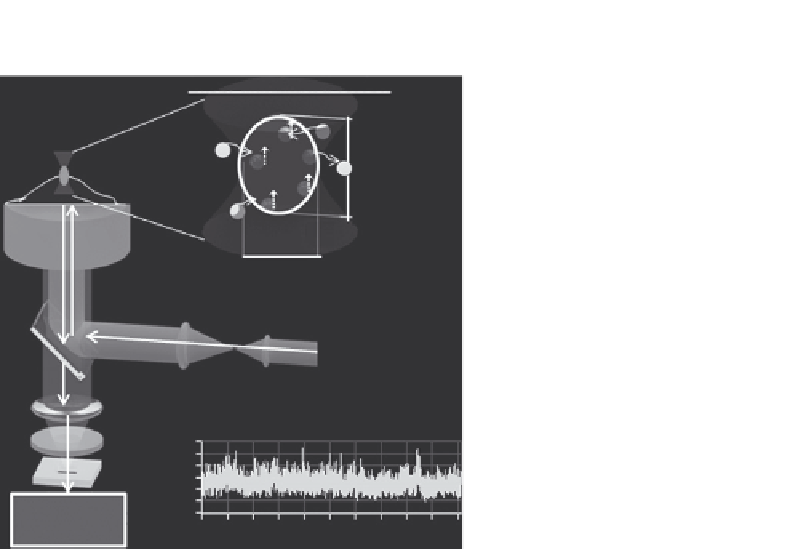Biology Reference
In-Depth Information
Laser-illuminated region
Confocal
observation
volume
(<1
Cell
m
m
3
)
Objective
l
em
l
ex
Dichroic mirror
Excitation
laser
beam
Beam expander
Lens
Count rate (kHz)
120
100
80
60
40
20
0
Emission filter
Pinhole
Photon
detector
0
1
2
3
4
5
6
7
8
9
10
Time (s)
FIGURE 10.1
FCS setup. A laser and a high numerical aperture objective are used to create a very small
observation volume focused on the upper plasma membrane of a cell. As fluorescent
molecules pass through the observation volume and are excited by the laser, the emitted
fluorescence is captured by the objective and is focused through a pinhole onto a photon
detector, which records the fluctuations in fluorescence over time.
As the fluorescence-tagged receptors pass through the laser-illuminated observa-
tion volume, the fluctuations in fluorescence intensity are recorded in real time by a
photon-counting detector. Autocorrelation analysis depicts the fluctuations in
fluorescence intensity as a function of particle number and diffusion time
(
M
ller, Chen, & Gratton, 2003
). FCS has been used to monitor diffusion and ligand
binding for ion channels, tyrosine kinase receptors, and G-protein-coupled
receptors (reviewed in
Briddon & Hill, 2008; Briddon, Hern, & Hill, 2010;
Jameson, James, & Albanesi, 2013
).
Fluorescence fluctuation data recorded during an FCS experiment can be used to
generate a photon-counting histogram (PCH), providing quantitative information
about the number of fluorescent molecules and the number of photon counts per mol-
ecule. PCH analysis uses a 3D Gaussian approximation of the laser beam profile and
Poisson statistics to predict what the molecular brightness of the fluorescent particle
would be when it is at the center of the observation volume (
Chen, Muller, So, &
Gratton, 1999
). Since the molecular brightness of a cluster is directly proportional
to the number of fluorescent molecules present in the cluster, molecular brightness
can be used to monitor receptor-receptor interactions and to determine the oligomer
ϋ



